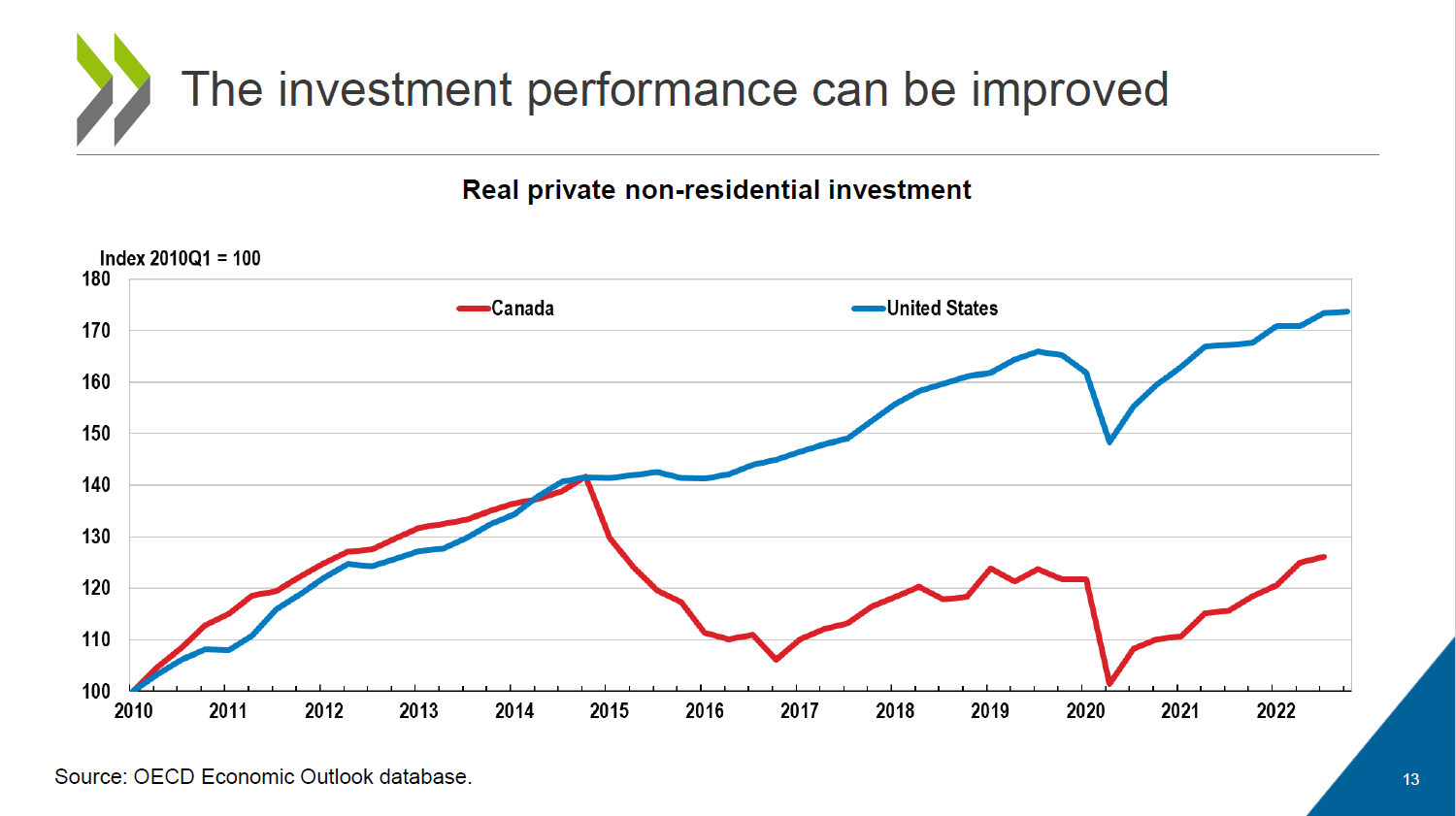Federal ‘green agenda’ unlikely to spur business investment

How will the Trudeau government’s latest budget influence the environment for private-sector investment in Canada? The question is timely given the unprecedented scale of new business subsidies and investment incentives unveiled in the budget. It’s also timely because business capital spending has been notably subdued in Canada for several years, a trend that has prompted growing concern among economists and think-tanks.
Indeed, in its recent report on Canada, the Organization for Economic Cooperation and Development (OECD) includes a striking chart (see below) depicting a large and widening capital spending gap with the United States. By the end of 2022, real non-residential business investment in the U.S. stood more than 70 per cent above the level recorded in 2010 while in Canada, the comparable increase was barely 25 per cent. Adjusted for inflation, business investment in Canada has actually fallen since 2014.

(Source: OECD)
In part, this is a story of retrenchment and capital outflows in the Canadian energy business, with the impact of this trend magnified due to the outsized role of energy production in the Canadian economy. But the weakness in private-sector non-residential investment is neither limited to nor concentrated in energy-related industries. In the broad Canadian manufacturing sector, for example, capital spending has dwindled to the point where it’s failing even to match ongoing depreciation, leading to a shrinking and increasingly outdated capital stock for Canadian manufacturers—companies that collectively supply more than half the country’s international merchandise exports.
Against this worrisome backdrop, how does the latest federal budget stack up?
The Trudeau government is betting that an aggressive taxpayer-subsidized “green agenda” will inject some life into moribund capital spending. To that end, Budget 2023 rolls out a series of tax incentives and direct spending initiatives aimed at spurring clean technology development and manufacturing, increasing the supply of no- and low-carbon electricity, and accelerating the shift toward less carbon-intensive production processes in the natural resource and manufacturing sectors. The hefty fiscal price tag of these climate-driven industrial policy measures in Budget 2023 is estimated at $21 billion over five years, rising to as much as $80 billion over the next decade.
Will the federal government’s “green” wager pay off? If the goal is to broadly revive flagging business investment, the answer is almost certainly no.
To see why, it’s important to understand that the industries that create and produce “clean/green” goods, services and technologies account for a tiny slice of the almost $3 trillion Canadian economy. According to Statistics Canada’s environmental and clean technology economic account, these industries represent less than 3 per cent of GDP—a share that has hardly budged in 15 years—while employing just 1.6 per cent of the country’s workforce. Even if the array of tax incentives and new spending in Budget 2023 succeeds in boosting private-sector investment and output in these industries, it will have only a small effect on aggregate economic indicators such as GDP growth, employment and total business capital outlays.
Which industries are part of Statistics Canada’s definition of the “clean/green” economy? The list includes renewable electricity, biofuels production, energy storage, waste management, sewage and wastewater treatment, carbon capture/storage, the manufacturing of clean technology products, and a mix of professional, scientific and technical services involved in protecting the environment and improving energy efficiency. Of interest, the biggest contributors to Canada’s “clean/green” economy are renewable power generation and waste management services—together, they produce more than half the sector’s output. Clean/green technologies and related manufactured goods comprise less than 1 per cent of GDP.
There’s another factor that also suggests the economic development strategy underlying Budget 2023 will yield meagre results—the composition of additional private-sector spending that may be leveraged through taxpayer-funded incentives and subsidies.
Across Canada’s natural resource and manufacturing industries, any increase in capital investment that occurs to enable companies to access government financial support will mainly aim to achieve compliance with regulations and standards set by Ottawa, as part of its climate policy. This should benefit companies that qualify for the government assistance, but there’s little reason to believe it will lead to more output (GDP), higher productivity or a greater market share for Canadian exporters. Business capital spending to ensure regulatory compliance isn’t the same as investments that companies voluntarily undertake to expand production, increase efficiency, improve product quality or make use of innovative technologies.
Add it all up, and it’s hard to see how the “clean economy” measures championed in Budget 2023 will move the overall business investment dial in a significant way. The alarming picture of Canada falling well behind the U.S. on business investment is unlikely to change anytime soon.
Author:
Subscribe to the Fraser Institute
Get the latest news from the Fraser Institute on the latest research studies, news and events.

